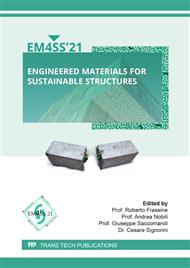p.3
p.15
p.21
p.28
p.35
p.49
p.55
p.65
Triaxial Tests on Hempcrete for Prefabricated Blocks Production
Abstract:
Nature-based solutions are sustainable building materials produced recovering and enhancing agricultural biomasses which are by-products or waste of crops as, for example, rice, flax or hemp. Specifically, this research investigates the properties of hempcrete which is produced mixing lime, which acts as binder, and hemp shives, as vegetal aggregate. Hempcrete is characterized by breathability and excellent insulating properties, moreover it is a sustainable material due to the introduction of vegetal material and due to the carbonation of lime which gives further carbon dioxide sequestration. The mechanical properties of the material are largely variable and, in this research, triaxial tests have been performed to evaluate this experimental methodology as a technique applicable to evaluate the mechanical behavior of this material. The tests have been performed on samples produced with the same mix design developed by an Italian manufacturer for the production of prefabricated hempcrete blocks. These building components are used as non-loadbearing blocks, they are introduced in building envelopes or in indoor partition walls as insulating elements.
Info:
Periodical:
Pages:
15-20
Citation:
Online since:
May 2022
Authors:
Price:
Сopyright:
© 2022 Trans Tech Publications Ltd. All Rights Reserved
Share:
Citation:


